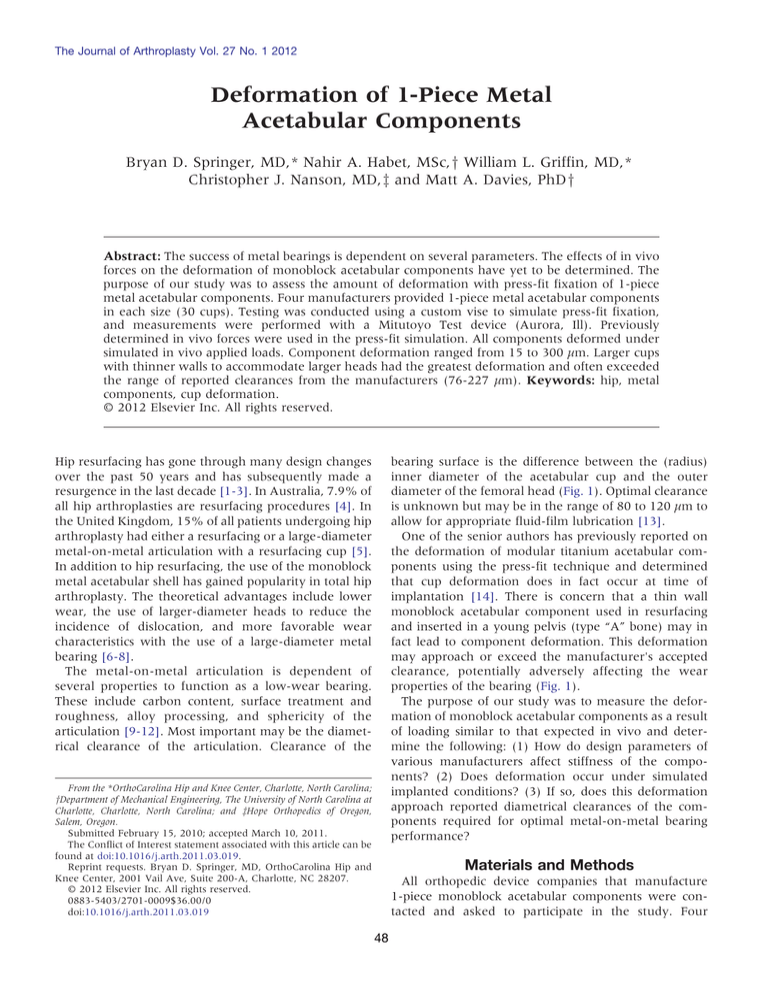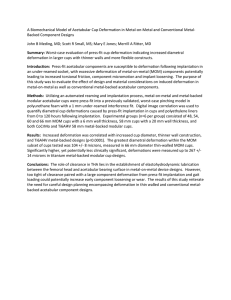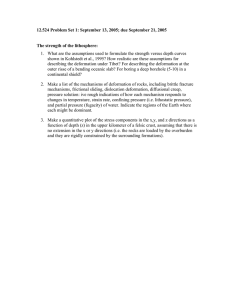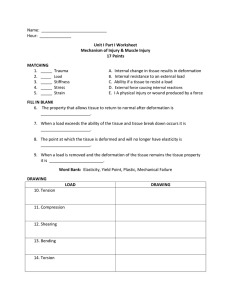Deformation of 1-Piece Metal Acetabular Components
advertisement

The Journal of Arthroplasty Vol. 27 No. 1 2012 Deformation of 1-Piece Metal Acetabular Components Bryan D. Springer, MD,* Nahir A. Habet, MSc,y William L. Griffin, MD,* Christopher J. Nanson, MD,z and Matt A. Davies, PhDy Abstract: The success of metal bearings is dependent on several parameters. The effects of in vivo forces on the deformation of monoblock acetabular components have yet to be determined. The purpose of our study was to assess the amount of deformation with press-fit fixation of 1-piece metal acetabular components. Four manufacturers provided 1-piece metal acetabular components in each size (30 cups). Testing was conducted using a custom vise to simulate press-fit fixation, and measurements were performed with a Mitutoyo Test device (Aurora, Ill). Previously determined in vivo forces were used in the press-fit simulation. All components deformed under simulated in vivo applied loads. Component deformation ranged from 15 to 300 µm. Larger cups with thinner walls to accommodate larger heads had the greatest deformation and often exceeded the range of reported clearances from the manufacturers (76-227 µm). Keywords: hip, metal components, cup deformation. © 2012 Elsevier Inc. All rights reserved. bearing surface is the difference between the (radius) inner diameter of the acetabular cup and the outer diameter of the femoral head (Fig. 1). Optimal clearance is unknown but may be in the range of 80 to 120 µm to allow for appropriate fluid-film lubrication [13]. One of the senior authors has previously reported on the deformation of modular titanium acetabular components using the press-fit technique and determined that cup deformation does in fact occur at time of implantation [14]. There is concern that a thin wall monoblock acetabular component used in resurfacing and inserted in a young pelvis (type “A” bone) may in fact lead to component deformation. This deformation may approach or exceed the manufacturer's accepted clearance, potentially adversely affecting the wear properties of the bearing (Fig. 1). The purpose of our study was to measure the deformation of monoblock acetabular components as a result of loading similar to that expected in vivo and determine the following: (1) How do design parameters of various manufacturers affect stiffness of the components? (2) Does deformation occur under simulated implanted conditions? (3) If so, does this deformation approach reported diametrical clearances of the components required for optimal metal-on-metal bearing performance? Hip resurfacing has gone through many design changes over the past 50 years and has subsequently made a resurgence in the last decade [1-3]. In Australia, 7.9% of all hip arthroplasties are resurfacing procedures [4]. In the United Kingdom, 15% of all patients undergoing hip arthroplasty had either a resurfacing or a large-diameter metal-on-metal articulation with a resurfacing cup [5]. In addition to hip resurfacing, the use of the monoblock metal acetabular shell has gained popularity in total hip arthroplasty. The theoretical advantages include lower wear, the use of larger-diameter heads to reduce the incidence of dislocation, and more favorable wear characteristics with the use of a large-diameter metal bearing [6-8]. The metal-on-metal articulation is dependent of several properties to function as a low-wear bearing. These include carbon content, surface treatment and roughness, alloy processing, and sphericity of the articulation [9-12]. Most important may be the diametrical clearance of the articulation. Clearance of the From the *OrthoCarolina Hip and Knee Center, Charlotte, North Carolina; yDepartment of Mechanical Engineering, The University of North Carolina at Charlotte, Charlotte, North Carolina; and zHope Orthopedics of Oregon, Salem, Oregon. Submitted February 15, 2010; accepted March 10, 2011. The Conflict of Interest statement associated with this article can be found at doi:10.1016/j.arth.2011.03.019. Reprint requests. Bryan D. Springer, MD, OrthoCarolina Hip and Knee Center, 2001 Vail Ave, Suite 200-A, Charlotte, NC 28207. © 2012 Elsevier Inc. All rights reserved. 0883-5403/2701-0009$36.00/0 doi:10.1016/j.arth.2011.03.019 Materials and Methods All orthopedic device companies that manufacture 1-piece monoblock acetabular components were contacted and asked to participate in the study. Four 48 Deformation of 1-Piece Metal Acetabular Components Springer et al 49 Fig. 1. Clearance is defined as the difference in the radius of the inner diameter of the acetabular cup and the radius of the outer diameter of the femoral head. A deforming force applied to the acetabular component at the time of insertion reduces the radius of the inner surface of the acetabular shell, thus reducing the overall clearance. companies—Biomet (Magnum) Warsaw, IN; Smith and Nephew (Birmingham), Memphis, TN; Wright Medical (Conserve Plus), Memphis TN; Stryker (Cormet), Mahwah, NJ)—donated the monoblock acetabular components to be tested (37 cups, Table 1). Only 2 sizes (56and 66-mm Biomet Magnum cups) were not available to be tested. All monoblock cups from the manufacturers were less than a hemisphere, measuring 160°. Institutional Review Board approval was not needed for this study given that it was biomechanical in nature and did not use human subjects. Funding was provided via a local research grant. Previously determined in vivo forces were used in the press-fit simulation to determine the amount of deformation that can occur with 1-piece acetabular shells. In that study, the force acting on the cup in vivo was calculated as the product of the measured deformation (in millimeters) and the stiffness of the cup (in newtons per millimeter). The in vivo forces acting on the cups averaged 412 N (range, 0-1539 N) but was 577 N (range, 99-1539N) in type A bone [14]. An apparatus was designed and built to transmit forces at the rim of the component in a direction commensurate with the largest loads resulting from the press-fit (Fig. 2). The apparatus applied equal and opposite forces over the range of predetermined loads to the components and allowed measurement of the resulting deformation compared with the unloaded cup. A cross-sectional profile of each component was measured before the application of any loads. The out-of-roundness measurements were preformed with a Mitutoyo Round Test RA-1500 instrument (Aurora, Ill) for the range of predetermined loads in increments of 200 N (Fig. 3). At each loading condition, the roundness measurements were conducted at different depths of the acetabular shells. An attempt was made to correlate these depths, and corresponding deformations, to transition zones along the component profiles. Results Design Parameters and Stiffness There were differences in the profile and thickness for each of the manufacturers' components tested. Tables 2 Table 1. Distribution of Cups Tested Manufacturer Smith and Nephew Biomet Cup No. of Cups Birmingham 12 Magnum 11 Wright Medical Conserve Plus Stryker Cormet Orthopaedics 7 7 Sizes (mm) 44, 46, 48, 50, 52, 54, 56, 58, 60, 62, 64, 66 44, 46, 48, 50, 52, 54, 58, 60, 62, 64 (missing 56 and 66) 42, 46, 48, 52, 56, 58, 62 50, 52, 54, 56, 58, 60, 62 Fig. 2. Graphic illustration of the apparatus designed and built to transmit forces at the rim of the component in a direction commensurate with the largest loads resulting from the press-fit. 50 The Journal of Arthroplasty Vol. 27 No. 1 January 2012 Table 3. Measured Values for Profile Assessment: Smith and Nephew Birmingham Outer Diameter (mm) Given 44.00 46.00 48.00 50.00 52.00 54.00 56.00 58.00 60.00 62.00 64.00 66.00 Thickness (mm) Measured Height (mm) At Pole At Rim Weight (kg) 44.60 46.29 48.13 50.16 52.15 54.17 56.26 58.34 60.33 62.46 64.32 66.24 20.96 23.21 23.90 23.92 24.99 26.05 27.00 27.71 28.98 27.41 31.02 32.28 5.58 6.47 5.70 6.52 5.63 6.69 5.53 6.53 5.58 6.61 5.64 7.02 3.75 4.54 3.43 4.55 3.42 4.62 3.42 4.53 3.47 4.49 3.47 4.36 0.096 0.118 0.111 0.139 0.132 0.166 0.150 0.194 0.172 0.230 0.209 0.261 Fig. 3. Mitutoyo Round Test RA-1500 instrument designed to measure deformation under applied loads. to 5 list the measured values for profile assessment of each component tested. For all components, the thickness at the pole ranged from 4.07 to 7.68 mm. The thickness at the rim ranged from 3.05 to 5.99 mm. For manufacturers that used the option of 2 cup sizes for a given head (Birmingham and Cormet, ie, 46-mm head with 52- or 54-mm acetabular shell), there were alterations in the thickness at the pole and rim to accommodate the head size. For example, a 52-mm cup with a 46-mm head was thinner at the dome and rim than a 54-mm cup with a 46-mm head. For manufacturers with one cup size per femoral head (Magnum and Conserve Plus), 2 trends were noted: (a) as the Table 2. Measured Values for Profile Assessment: Biomet Magnum Outer Diameter (mm) Given 44.00 46.00 48.00 50.00 52.00 56.00 58.00 60.00 62.00 64.00 66.00 Thickness (mm) Measured Height (mm) At Pole At Rim Weight (kg) 44.09 46.04 48.10 49.99 52.06 56.03 58.02 60.08 62.02 63.85 65.96 femoral head got larger, the pole thickness remained relatively constant, whereas the rim got thinner; or (b) as the femoral head got larger, the pole and the rim were thickened. Stiffness (in newtons per millimeter) was determined for each manufacturer's components in each size. Fig. 4 lists the stiffness for each component tested. Two stiffness patterns were determined that correlated with 22.15 23.22 23.71 25.02 26.29 28.17 29.26 30.53 31.10 32.12 33.02 5.80 5.99 5.60 5.88 5.97 5.84 5.80 5.86 5.88 5.88 5.83 3.33 3.32 3.36 3.31 3.46 3.23 3.26 3.23 3.22 3.13 3.05 0.086 0.090 0.096 0.108 0.120 0.142 0.147 0.159 0.166 0.183 0.188 Table 4. Measured Values for Profile Assessment: Wright Medical Conserve Plus Outer Diameter (mm) Given 42.00 46.00 48.00 52.00 56.00 58.00 62.00 Thickness (mm) Measured Height (mm) At Pole At Rim Weight (kg) 43.39 47.22 49.13 53.03 57.23 59.23 63.30 20.13 22.17 23.19 25.22 27.08 28.24 30.18 4.07 4.33 4.52 4.61 4.73 4.82 4.89 3.80 3.74 3.83 3.81 3.85 3.88 3.87 0.075 0.091 0.102 0.120 0.144 0.156 0.180 Deformation of 1-Piece Metal Acetabular Components Springer et al Table 5. Measured Values for Profile Assessment: Stryker Cormet Outer Diameter (mm) Given Thickness (mm) Measured Height (mm) At Pole At Rim Weight (kg) 50.00 52.00 54.00 56.00 58.00 60.00 62.00 52.08 54.03 56.13 58.04 59.78 62.16 64.24 26.42 26.37 27.53 28.42 28.96 30.38 31.47 6.78 7.60 6.89 7.65 6.35 7.68 6.86 4.45 5.49 4.32 5.51 4.21 5.50 4.52 0.149 0.182 0.176 0.216 0.191 0.248 0.237 51 Acetabular Component Deformation Figs. 5 to 8 list the deformation that occurred at the rim in micrometers for a given applied load for all components tested. Using the predetermined average in vivo force of 412 N, all components deformed. This deformation ranged from approximately 10 to 75 µm. Deformation vs Reported Clearance For patients with type A bone, the predetermined force was 577 N (range, 99-1539 N). This deformation ranged from approximately 10 to 120 µm. The range of predetermined forces was from 0 to 1539 N. This deformation ranged from 0 to approximately 300 µm. The manufacturers' reported range of clearance for all components tested ranged from 76 to 227 µm. Discussion the initial profile measurements. For components with one femoral head size and 2 acetabular components, there was an alternating pattern of stiffness based on the thickness of the components. For components with one head size per acetabular shell, there was a linear decrease in the stiffness of the components as the shell became thinner. One of the key parameters affecting the performance of a metal-on-metal bearing is the diametrical difference or clearance between the 2 bearing surfaces. Lower clearance allows for better joint tribology and better wear characteristics [10,11]. Dowson et al [13] demonstrated a direct correlation between low clearance and low wear and stated that optimal metal-on-metal tribology should include the largest head with the lowest possible clearance. With optimal reported diametrical clearances in the range of 80 to 120 µm, any deformation has the potential to create adverse tribological properties including equatorial contact, runaway wear, seizing of the bearing, and possibly early loosening or failure of ingrowth of the cup if stress is transferred to the acetabular- 45000 40000 35000 Stiffness (N/m mm) 30000 Smith & Nephew Birmingham 25000 Stryker Cormet Wright Medical Conserve Plus 20000 Biomet Magnum 15000 10000 5000 0 42 44 46 48 50 52 54 56 58 60 62 64 66 Cup Size (mm) Fig. 4. Comparison of stiffness for all components tested. 52 The Journal of Arthroplasty Vol. 27 No. 1 January 2012 400 44 mm 350 46 mm Deformation (um) 300 48 mm 50 mm 250 52 mm 200 56 mm 58 mm 150 60 mm 100 62 mm 64 mm 50 66 mm 0 0 200 400 600 800 1000 1200 1400 1600 1800 2000 Force (N) Fig. 5. Cup deformation: Biomet Magnum. bone interface [15]. The purpose of our study was to use a previously designed biomechanical test to assess the amount of cup deformation that occurs under certain loads. By doing so, we were able to create a stress-strain relationship for each cup size of different design. Secondly, using previously recorded data on the in vivo forces of acetabular cup deformation, we were able to develop a relationship of the stress encountered at the time of surgery and its implication to the amount of strain or deformation placed on the cup. There are several limitations to our study. Our model does not take into account the viscoelastic properties of bone or the fact that plastic deformation of bone occurs at the time of implantation. It is likely that, over time, stress relaxation occurs; thus, the amount of deformation may lessen with time. Griffin et al [16] have shown that stress relaxation following implantation of modular titanium acetabular components does occur over time. Shell deformation relaxed by 12.5% over the first 5 hours after implantation. Slower relaxation occurred over the next 24 hours. Extrapolation of the average curve, however, predicted that complete relaxation did not occur until 25 days after implantation. Initial deformation therefore is important and may affect initial wear properties, fluid tribology, and most importantly stress transfer to the bone-implant interface. In addition, the amount of press-fit used to implant the cup may vary and is surgeon dependent. The technical monographs for each of the tested component were reviewed, and each company recommends between a 1- and 3-mm press-fit technique depending on bone quality that does not vary with the size of the component to be inserted. In addition, force was applied in a simulated manner, in equal and opposite directions. This may not exactly replicate the forces experienced in an in vivo setting. Clinically, it may be difficult to perfectly ream the acetabular cavity to a perfect sphere; and variable bone quality may affect the amount of deformation that may take place. Widmer et al [17] have shown that cups are primarily loaded in a 3-point fixation manner between the ilium, ischium, and pubic bones. His study also demonstrates, however, that it is the ilioischial diagonal axis that develops and contributes most to the press-fit fixation. In addition, press-fit fixation, with oversizing of the acetabular socket, redirects the forces to the periphery, which according to our study is susceptible to 200 44 mm 180 46 mm Deformation (um) 160 48 mm 140 50 mm 120 52 mm 100 54 mm 80 56 mm 60 58 mm 40 60 mm 20 62 mm 0 0 500 1000 1500 2000 Force (N) Fig. 6. Cup deformation: Smith and Nephew Birmingham. 64 mm 66 mm Deformation of 1-Piece Metal Acetabular Components Springer et al 53 180 Deformation (um) 160 140 42 mm 120 46 mm 48 mm 100 52 mm 80 56 mm 60 58 mm 40 62 mm 20 0 0 200 400 600 800 1000 1200 1400 1600 1800 Force (N) Fig. 7. Cup deformation: Wright Medical Conserve Plus. deformation. In addition, Squire et al [14] demonstrated that deformation did occur in a pinch-like manner using calipers to measure amount of deformation after pressfit fixation with a modular acetabular shell at the time of surgery. Jin et al [25] have shown in cadaveric models with resurfacing shells that deformation occurred primarily as a result of squeezing between the ischial and iliac columns. Therefore, our study and those above most likely represent the “worst case” scenario for pressfit fixation for monoblock metal resurfacing shells. There are several studies in the literature that focus on varying parameters of press-fit fixation model of modular acetabular cups in total hip arthroplasty [10,17-22]. These studies focus however on initial stability and pelvic deformation with press-fit fixation. Little information exists on the deformation of 1-piece metal resurfacing shells and the potential adverse effects it may have on the tribological properties of the metal-on-metal bearing. Recently, Schmidig et al [23] evaluated modular cup deformation with highly cross-linked polyethylene liners to determine its effects on frictional torque. The deformed acetabular shells produced higher frictional torques compared with nondeformed shell. Frictional torques were increased with the use of larger-diameter femoral heads. A deformed 1-piece metal acetabular shell with a large-diameter metal head may therefore be at particular risk for increased frictional torque that may lead to failure of ingrowth or early loosening. Long et al [24] reported a 15% revision rate of a 1-piece monoblock metal acetabular component at a mean of 1.6 years. Seventy-nine percent of those revisions were for loosening or failure of ingrowth of the acetabular component. Jin et al [25] evaluated 2 prototype monoblock acetabular cups implanted into a foam acetabular model. The thin-walled cup (2.3 mm at periphery and 4 mm at dome) deformed between 60 and 100 µm with a pressfit technique of 1 mm. This amount of deformation was deemed to be excessive when compared with diametrical clearances of 80 to 120 µm thought to be ideal for optimal metal-on-metal tribology. The measurements of this thin-walled prototype were thinner than all of the current designs tested in this study (Tables 1-4). When the component was thickened at the dome to 6 mm and the walls thickened to 3.5 mm, the amount of deformation decreased to fewer than 50 µm. This study however evaluated only one size (60 mm) of acetabular component that was a prototype model and not commercially available. Deformation (um) 80 70 50 mm 60 52 mm 54 mm 50 56 mm 40 58 mm 30 60 mm 20 62 mm 10 0 0 500 1000 1500 Force (N) Fig. 8. Cup deformation: Stryker Cormet. 54 The Journal of Arthroplasty Vol. 27 No. 1 January 2012 Our results showed several interesting findings. Not all manufacturers' components are designed the same. For any given size, there are differences in the thickness of the cup at both the pole and rim of the components. Some manufacturers account for larger head sizes by “thinning” the cup, thus potentially leading to more deformation, whereas others vary the thickness of the pole and rim to accommodate the head. For manufacturers that used the option of 2 cup sizes for a given head (Birmingham and Cormet, ie, 46-mm head with 52- or 54-mm acetabular shell), there were alterations in the thickness at the pole and rim to accommodate the head size. For example, a 52-mm cup with a 46-mm head was thinner at the dome and rim than a 54-mm cup with a 46-mm head. For manufacturers with one cup size per femoral head (Magnum and Conserve Plus), 2 trends were noted: as the femoral head got larger, the pole thickness remained relatively constant, whereas the rim got thinner; or as the femoral head got larger, the pole and the rim were thickened. Yew et al [26] used finite elemental simulation designed around the parameters in the study mentioned above. This study concluded that the most important parameter affecting deformation is the cup wall thickness, with thinner-walled cups experiencing more deformation; and this deformation increased as the interference fit increased. Our study indicates that all components deformed at a predetermined in vivo force, regardless of design parameter. This amount of deformation was under but did approach the range of manufacturers' tolerances for clearance. These cups however are often implanted in younger, healthier bone (type A), in which case the forces may be higher. When applying the forces often seen in these patients (577 N), the amount of deformation approached and often exceeded the known clearances of the components. References 1. Amstutz HC, Le Duff MJ. Background of metal-on-metal resurfacing. Proc Inst Mech Eng [H] 2006;220:85. 2. Grigoris P, Roberts P, Panousis K, et al. The evolution of hip resurfacing arthroplasty. Orthop Clin North Am 2005; 36:125. 3. Grigoris P, Roberts P, Panousis K, et al. Hip resurfacing arthroplasty: the evolution of contemporary designs. Proc Inst Mech Eng 2006;220:95. 4. No Authors Listed: National joint replacement registry annual report. Aust Orthop Assoc 2007;75. 5. No Authors Listed: National joint registry for England and Wales—annual report 2008. Available at: www.njrcentre. org.uk. 6. Amstutz HC, Beaule PE, Dorey FJ, et al. Metal-on-metal hybrid surface arthroplasty: two to six-year follow-up study. J Bone Joint Surg Am 2004;86:28. 7. dela Rosa MA, Silva M, Heisel C, et al. Range of motion after total hip resurfacing. Orthopedics 2007;30:352. 8. Allen DJ, Beaule PE. Rationale for metal-on-metal total hip replacement. J Surg Orthop Adv 2008;17:6. 9. Dowson D, Jin ZM. Metal-on-metal hip joint tribology. Proc Inst Mech Eng [H] 2006;220:107. 10. Harper P, Williams S, Isaac GH, et al. The influence of clearance on friction, lubrication and squeaking in large diameter metal-on-metal hip replacements. J Mater Sci Mater Med 2008;19:1575. 11. Isaac GH, Thompson J, Williams S, et al. Metal-on-metal bearings surfaces: materials, manufacture, design, optimization, and alternatives. Proc Inst Mech Eng 2006;220:119. 12. Jacobs JJ, Urban RM, Hallab NJ, et al. Metal-on-metal bearing surfaces. J Am Acad Orthop Surg 2009;17:69. 13. Dowson D, Hardaker C, Flett M, et al. hip joint simulator study of the performance of metal-on-metal joints: part II: design. J Arthroplasty 2004;8(Suppl 3):124. 14. Squire M, Griffin WL, Mason JB, et al. Acetabular component deformation with press-fit fixation. J Arthroplasty 2006;21(6(Suppl 2)):72. 15. Rieker CB, Schon R, Konrad R, et al. Influence of the clearance on in-vitro tribology of large diameter metal-onmetal articulations pertaining to resurfacing hip implants. Ortho Clin North Am 2005;36:135. 16. Griffin WL, Ernsberger C, Nofts R. Acetabular component deformation with press-fit fixation—does it persist? Presented at the Annual Meeting. February; American Academy of Orthopaedic Surgeons; New Orleans, LA; 2010. 17. Widmer KH, Zurfluh B, Morscher EW. Load transfer and fixation mode of press-fit acetabular sockets. J Arthroplasty 2002;17:926. 18. Baleani M, Fognani R, Toni A. Initial stability of a cementless acetabular cup design: experimental investigation on the effect of adding fins to the rim of the cup. Artif Organs 2001;25:664. 19. Kroeber M, Ries MD, Suzuki Y, et al. Impact biomechanics and pelvic deformation during insertion of press-fit acetabular cups. J Arthroplasty 2002;17:349. 20. Macdonald W, Carlsson LV, Charnley GJ, et al. Press-fit acetabular cup fixation: principles and testing. Proc Inst Mech Eng [H] 1999;213:33. 21. MacKenzie JR, Callaghan JJ, Pedersen DR, et al. Areas of contact and extent of gaps with implantation of oversized acetabular components in total hip arthroplasty. Clin Orthop Related Res 1994;298:127. 22. Ries MD, Harbaugh M. Acetabular strains produced by oversized press fit cups. Clin Orthop Related Res 1997;334:276. 23. Schmidig G, Patel A, Liepins I, et al. The effects of acetabular shell deformation and liner thickness on frictional torque in ultrahigh-molecular weight polyethylene acetabular bearings. J Arthroplasty 2010;25:644. 24. Long WT, Dastane M, Harris MJ, et al. Failure of the Durom Metasul acetabular component. Clin Orthop Related Res 2010;468:400. 25. Jin ZM, Meakins S, Morlock MM, et al. Deformation of press-fitted metallic resurfacing cups. Part 1: experimental simulation. Proc Inst Mech Eng 2006;220:311. 26. Yew A, Jin ZM, Donn A, et al. Deformation of press-fitted metallic resurfacing cups. Part 2: finite element simulation. Proc Inst Mech Eng 2006;220:311.


